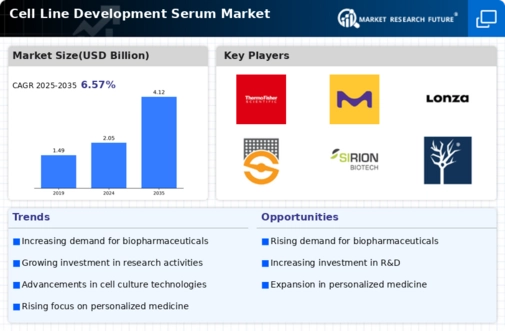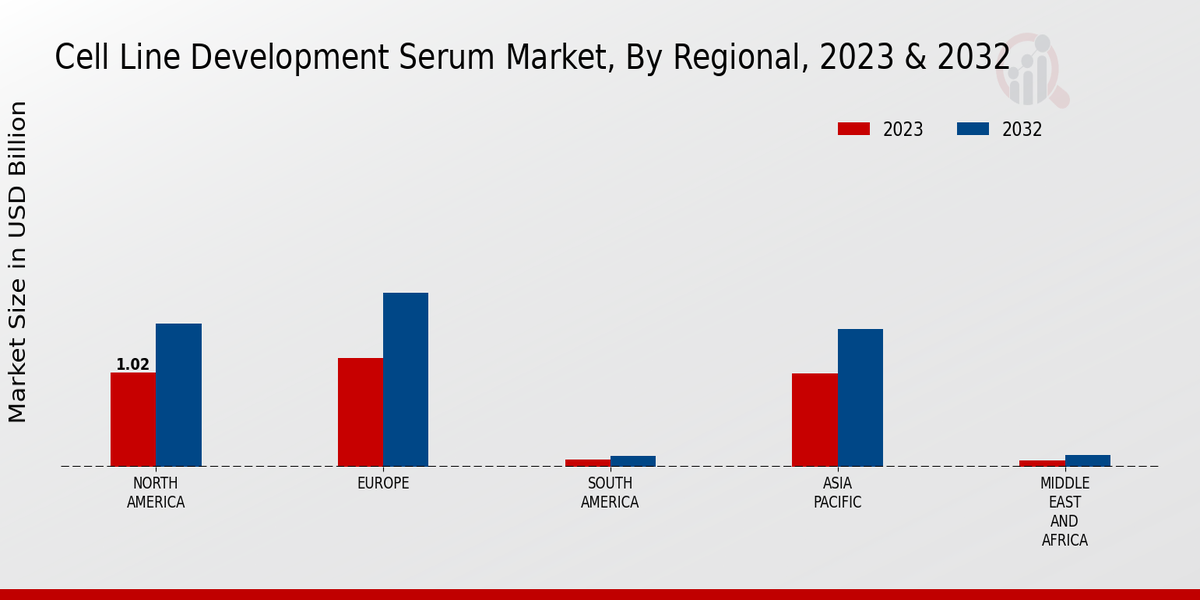Market Growth Projections
The Global Cell Line Development Serum Market Industry is projected to experience substantial growth over the next decade. The market is expected to reach a value of 2.05 USD Billion in 2024 and is anticipated to grow to 4.12 USD Billion by 2035. This growth trajectory suggests a compound annual growth rate (CAGR) of 6.56% from 2025 to 2035. Such projections reflect the increasing reliance on cell line development serums in various applications, including drug discovery and regenerative medicine. The market's expansion is indicative of the broader trends within the biotechnology sector, highlighting the critical role of cell line development in advancing scientific research.
Rising Demand for Biopharmaceuticals
The increasing demand for biopharmaceuticals is a primary driver of the Global Cell Line Development Serum Market Industry. As the biopharmaceutical sector expands, the need for efficient cell line development processes becomes critical. This trend is evidenced by the projected market value of 2.05 USD Billion in 2024, which is anticipated to grow significantly. The rise in chronic diseases and the need for personalized medicine further fuel this demand, as researchers require high-quality cell lines for drug development and testing. Consequently, the Global Cell Line Development Serum Market Industry is likely to experience robust growth as it supports the biopharmaceutical industry's evolving needs.
Growing Focus on Personalized Medicine
The growing focus on personalized medicine is a pivotal factor driving the Global Cell Line Development Serum Market Industry. As healthcare shifts towards tailored therapies, the need for specific cell lines that can mimic patient responses becomes increasingly important. This trend necessitates the use of specialized cell line development serums that cater to diverse genetic backgrounds. The market's growth trajectory, projected to reach 4.12 USD Billion by 2035, underscores the significance of personalized medicine in shaping research priorities. Consequently, the Global Cell Line Development Serum Market Industry is poised to expand as it aligns with the evolving landscape of personalized healthcare.
Regulatory Support for Biotech Innovations
Regulatory support for biotechnology innovations plays a crucial role in the Global Cell Line Development Serum Market Industry. Governments worldwide are implementing policies that facilitate the development and commercialization of biopharmaceutical products. This supportive regulatory environment encourages investments in cell line development, as companies seek to comply with evolving standards. The anticipated market growth, reaching 2.05 USD Billion in 2024, indicates a favorable climate for innovation. As regulations become more conducive to biotechnological advancements, the Global Cell Line Development Serum Market Industry is likely to benefit from increased activity and investment.
Technological Advancements in Cell Culture
Technological advancements in cell culture techniques are reshaping the Global Cell Line Development Serum Market Industry. Innovations such as 3D cell culture and automated systems enhance the efficiency and reproducibility of cell line development. These advancements allow for more accurate modeling of human physiology, which is crucial for drug discovery and development. As a result, the market is expected to witness a compound annual growth rate (CAGR) of 6.56% from 2025 to 2035. The integration of advanced technologies not only improves the quality of cell lines but also reduces development time, thereby driving the growth of the Global Cell Line Development Serum Market Industry.
Increased Investment in Research and Development
Increased investment in research and development (R&D) activities is significantly influencing the Global Cell Line Development Serum Market Industry. Governments and private entities are allocating substantial funds to enhance biotechnological research, which directly impacts the demand for cell line development serums. This trend is particularly evident in regions with strong biopharmaceutical sectors, where R&D spending is on the rise. As the market evolves, the anticipated growth to 4.12 USD Billion by 2035 reflects the importance of R&D in driving innovation and product development within the Global Cell Line Development Serum Market Industry.























Leave a Comment